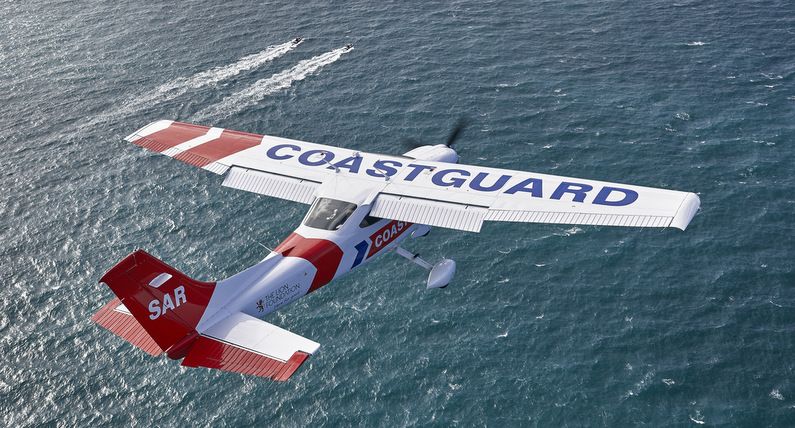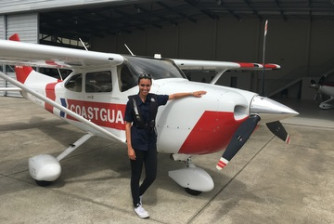
Coastguard Air Patrol
The Coastguard Air Patrol can search up to 35 square miles of water and shoreline per hour, reducing the time needed to cover large search areas and improving SAR outcomes.
First taking to the skies in 1991, in Air Patrol’s heyday, there were 10 units operating around New Zealand. Over time, the pressure of resourcing constraints versus rates of operational callouts means that today, only Northland and Auckland remain with dedicated search aircraft.
Alan Murgatroyd was a founding member and a past president of the Northland Coastguard Air Patrol. “When the decision was made to form a Northland Air Patrol, aero clubs from Whangarei, Ruawai, Dargaville, Kaitaia and Kerikeri put their hands up for the honour,” he recalls. “Our club president convinced the Royal New Zealand Coastguard Federation [as it was known then] that Kerikeri was the most suitable location, and it’s been based here ever since”
The club soon purchased a brand-new Cessna 172, with the registration ZK-CGD (Coastguard), and maintained a roster of qualified volunteer pilots seven days a week. Changes at their home airport meant the club had to shift to a brand-new hangar and sell the aircraft to finance the build. This became the impetus for the creation of the Northland Coastguard Air Patrol as a charitable organisation, to help attract and manage funding for dedicated hangar and operations room space at their new premises.
Without their own aircraft, they operated on patrols with a leased aircraft. Later, the new president of the Bay of Islands Aero Club allowed the air patrol to use his own Piper Cherokee aircraft and generously gifted the aircraft to the patrol when he eventually left the aero club.
Today, 24 volunteers contribute to the operation of a dedicated Cessna 182 aircraft, which is funded through unit fundraising, local community grant schemes and support from Coastguard. Last year they gave over 1,605 volunteer hours to support Coastguard operations in their region.
Since 2011, the Auckland Air Patrol has also operated a dedicated Cessna 182 aircraft, registered as ZK-SAR, which replaced another C182. According to Jonny Banister, Coastguard Regional Manager – Northern, “the C182 provides the right balance of affordability and capability for the role. As a dedicated search aircraft, we were able to install fit-for purpose equipment at the factory to make it a capable search platform.”
At the core of the onboard SAR equipment is the Garmin G1000, an electronic flight instrument system. The G1000 consists of two display units. One is the primary flight display used by the pilot to control the aircraft’s flight path, and the other a multi-function display, which has a number of inbuilt SAR functions like plotting search patterns, which can then be slaved to the pilot’s primary flight display. It is one of the most popular integrated glass cockpit solutions for general aviation and business aircraft, so as well as being extremely useful for SAR missions, it allows the volunteers to gain quality experience that they can use elsewhere in aviation if they wish.
Banu Pashutanizadeh – Auckland Air Patrol Volunteer Pilot. Courtesy Coastguard

The Cessna 182 also carries automatic direction finding (ADF) equipment, which is relatively standard for SAR aircraft. The ADF can give relative bearing information to a distress beacon, or other radio transmission, such as a “mayday” call to aid in its location. Likewise, marine frequency capable radios are fitted in addition to the standard aviation sets. Finally, a hand-held iPad provides a data-entry and recording point and is used by the in-flight observer, complementing the aircraft’s inbuilt system.
Auckland Air Patrol operates with a crew of three, consisting of a Pilot, In-Flight Coordinator and In-Flight Observer. Whilst the Pilot’s job is to manage the safe flight of the aircraft, the In-Flight Coordinator is responsible for the search mission. They brief the search patterns and tactics and direct the aircraft around the sky. They are also responsi- ble for communicating with Coastguard Communications, based at Mechanics Bay, and any other vessels or SAR assets involved in the operation. The In-Flight Observer sits behind the pilot on the left-hand side, observing and marking objects of interest on the iPad, and keeps a log of the flight and the search mission.
The C182 cruises at comparable speeds (130 knots) to many of the SAR sector helicopters, but is equal or superior in endurance. Search patterns are typically conducted at 80 knots and 500 feet. The Cessna is able to remain airborne up to four and a half hours at a time, and at a fraction of the cost of a helicopter.
But that’s not to say the two types of airborne SAR assets don’t work together. “I can think of three operations that I’ve been involved with, where we were in the air at the same time as the Westpac Rescue Helicopter or the Police Eagle,” says Jonny. “Each platform scoured different parts of the search area, depending on their capabilities. The helicopters flew at low altitude and low speed conducting a shoreline search, while we flew higher and further out to sea. The whole time, the pilots of each aircraft were in communication with each other to avoid collision and to coordinate rapid and very thorough coverage of the search area.”
Being in the Auckland Air Patrol requires the volunteers to complete the Coastguard SAR training program. Volunteers regularly attend rostered shifts at Ardmore airfield during weekends and public holi- days, and are on-call at other times. The shifts are broken down into AM and PM each day so that there are four crews each weekend and training or tasking flights take place on each shift. The Auckland Air Patrol can be called to assist within a 75 nautical mile radius of the airfield, and most of their work takes place in and around the Hauraki Gulf, Firth of Thames and Auckland’s west coast.
Since Project Horizon and the amalgamation of Coastguard into one national body, Auckland Air Patrol are occasionally being tasked to operations outside of their usual home range. “Our first major incident was responding to the Whakaari/White Island eruption and both Coastguard Air Patrol units attended,” remembers Jonny. “Our Auckland unit has since been involved in three other searches when we have been out on multiple days over large areas of water and shoreline.” For the Auckland unit, altogether 38 volunteers responded to
29 callouts last year, devoting 903 volunteer hours to assist 10 people to come home safely, and as Jonny says “contributing to saving lives is the reason our people do what they do."
This article was first published in the September 2022 issue of Link Magazine.
